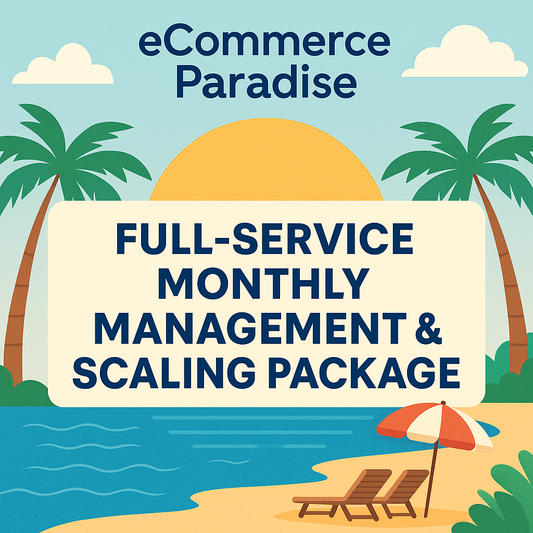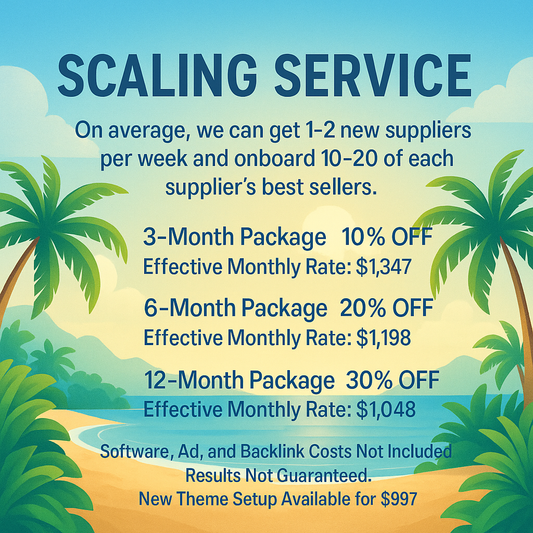
Unlocking Success: Optimizing Your Shopify Store’s URLs
Welcome to the vibrant world of eCommerce! I'm Trevor Fenner, founder of Ecommerce Paradise, and today we’re diving deep into a topic that can significantly enhance your Shopify store's performance: URL structure. An optimized URL structure is a crucial piece of the SEO puzzle, ensuring your store gains visibility on Google and converts visitors into loyal customers. Let’s explore the best practices to fine-tune your URLs for maximum impact!
Understanding the Importance of URL Structure
Before we get into the nitty-gritty, let’s discuss why URL structure matters. A well-structured URL is not just about aesthetics; it plays a pivotal role in how search engines index your pages and how users interact with your site.
SEO Benefits
Search Engine Optimization (SEO) is the backbone of any successful online store. URLs serve as a way for search engines to understand what your page is about. A clear and concise URL structure helps Google and other search engines crawl your site efficiently, resulting in better rankings for your products.
User Experience
Imagine visiting a site with an URL that looks like a random string of numbers and letters. Confusing, right? User-friendly URLs enhance the shopping experience. They give customers a clear idea of what to expect when they click a link. This clarity can significantly impact conversion rates.
Elements of a Great URL Structure
Now that we understand the significance behind URL structure, let’s break down the key components:
- Keywords: Incorporate relevant keywords that reflect the content of your page. Think about how people search for what you sell.
- Readability: Your URLs should be easy to read. Aim for clarity over complexity.
- Consistency: Maintain a uniform structure across your entire website to help users and search engines navigate your site easily.
Step-by-Step Guide to Optimize Your Shopify Store’s URLs
Ready to transform your store's URLs? Here’s a straightforward guide to help you get started:
1. Planning Your Structure
Before you dive into making changes, take a moment to plan your URL structure. A well-organized hierarchy will not only help with SEO but also with user navigation.
- Category-Based Structure: Start by organizing your products into meaningful categories. A category-based structure (e.g., ecommerceparadise.com/category/product) is both user-friendly and SEO-friendly.
- Use Simple Language: Stick to common terms that your target audience would use in their searches.
2. Implement SEO Keywords
Integrating relevant keywords directly into your URL can enhance your visibility in search results. Make sure to include important keywords related to your products or services, which can help your pages rank on Google Shopping Ads.
3. Avoid Special Characters
Stay away from special characters, numbers, or irrelevant symbols. These can confuse both users and search engines. Opt for hyphens to separate words instead of underscores or other characters.
4. Optimize for Readability
Your URLs should be human-readable. For instance, instead of using a URL like ecommerceparadise.com/1234ABCD, use ecommerceparadise.com/dropshipping-guides. This not only makes it easy for customers to understand the link but also improves its relevance for search queries.
5. Using Lowercase Letters
Always use lowercase letters in your URLs. This helps maintain uniformity and prevents potential duplicate content issues caused by case sensitivity.
6. Redirect Wisely
If you’re making major changes to your existing URLs, be sure to set up 301 redirects from the old URLs to the new ones. This preserves your SEO juice and ensures that you don’t lose traffic or rankings when you change URL structures.
Linking Strategies to Enhance Your URL Structure
A robust internal linking strategy can complement your URL optimization efforts. Here are some tips to consider:
Building Internal Links
Link relevant pages within your Shopify store to keep users engaged and reduce bounce rates. Internal links also help search engines understand the importance of your content. For example, if you’re writing about "Email Marketing," link to relevant products or articles on your website to provide more value to your audience.
External Linking
Engaging in external linking, when appropriate, can also ramp up your SEO. Link to credible sources that enhance the value of your content, leading to increased trust from both your audience and search engines. Keep in mind that quality over quantity is essential here.
Analyzing Your URL Structure
After making the necessary changes, it’s important to analyze your new URL structure. Use tools like Google Search Console to check how your URLs are performing and see if they’re being indexed correctly.
- Monitor Traffic: Keeping an eye on traffic sources will help you understand if your optimizations are working.
- Adjust Accordingly: If you notice certain URLs aren’t performing well, don’t hesitate to tweak them for better results.
The Bigger Picture: Integrating with Overall SEO Strategy
URL optimization is just one piece of the SEO puzzle. To propel your Shopify store to new heights, it’s essential to integrate your URL strategy with an overarching SEO strategy. This includes:
Content Marketing
Develop a content marketing plan that complements your eCommerce SEO efforts. Engaging blog posts, product guides, and customer testimonials can enhance your store's relevance, driving organic traffic your way.
Utilizing Google Shopping Ads
While you focus on optimizing your URLs, don’t forget to leverage Google Shopping Ads. Using clear and optimized URLs in your ad campaigns can lead to higher click-through rates and, ultimately, conversions. Make sure your ads align well with your SEO efforts!
Final Thoughts on URL Structure Optimization
Remember, creating a well-optimized URL structure is an ongoing process. Stay updated on SEO best practices, monitor your performance, and make adjustments as needed. By offering your customers a seamless shopping experience while improving your store's visibility, you pave the way for long-term success. Embrace the power of effective URL structures, and watch your Shopify store thrive in the bustling eCommerce landscape!


















